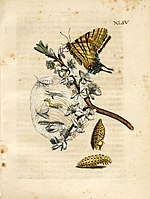The caterpillars wonderful transformation and strange flower food
The caterpillars' wonderful transformation and strange flower food (also known as the caterpillar book ) is the second work of the naturalist Maria Sibylla Merian (1647–1717). The first two volumes appeared in 1679 and 1683, initially in German . The book met with great scientific interest and made Merian known nationwide.
The full title of the first issue was: The caterpillars wonderful transformation / and ſpecial flowernutrition / where / by a completely new invention / The caterpillars / worms / summer birds / moths / flies / and other similar animals / origins / food / and changes / with their time / place / and characteristics / at the service of nature lovers / art grinders / and garden lovers / diligently examined / recently described / ground down after life / engraved in copper / and ſelbſt published / by Maria Sibylla Graäffinn / des Matthæi Parents / soul. Daughter.
plant
The “caterpillar book” followed Merian's three-part New Flower Book . In contrast to this, there were primarily her own long-term observations. Maria Sibylla Merian had observed and collected insects since her youth; she also raised butterflies herself so that she could study them more closely. She meticulously recorded her scientific findings and sketches in a “study book”.
Merian designed the panels - 50 per volume - initially “with watercolor and opaque paints ” before engraving them in copper. Upon request, she also colored the prints herself.
The copperplate engravings show the developmental stages ( egg , caterpillar , pupa and imago ) of different butterfly species arranged in a "closed cycle" around a forage plant. Merian therefore not only depicted the insects themselves, but also their habitat, and showed a "wide-awake look that was sensitive to the smallest details". There was also an extensive accompanying text.
The caterpillar book was published in four editions during her lifetime; by 1771 five more appeared.
With her caterpillar book, Merian played an important role in the development of modern, scientific entomology . According to Anne-Charlott Trepp , however, the book should serve devotion, as the sentence in the foreword already shows: "So look here, not my glory, but God's glory to praise Him as a creator of even these smallest and smallest worms." a tradition of natural piety that was widespread in Nuremberg at this time, the search for God in the most insignificant creatures.
Wild buttercup (Plate 15)
Blackthorn (Volume 2, Plate 44), colored
The 500 DM banknote with the illustration of plate 8
Third volume
Maria Sibylla Merian worked until her death on a third part of the caterpillar book, which was supposed to describe her observations in Friesland and Holland . It finally appeared in Dutch , completed by her daughters, in 1717 .
Further editions
An edition in Dutch ( Der Rupsen Begin, voedzel en Wonderbaare Verandering ), translated and revised by Merian himself, was published in 1713 and 1714 by Gerard Valk in Amsterdam .
A three-part Latin version appeared in 1718, after Merian's death, as Erucarum Ortus, Alimentum Et Paradoxa Metamorphosis . with Johannes Oosterwijk (Oosterwyk) in Amsterdam.
Finally, in 1730 the work was reissued in an expanded edition in Dutch ( De Europische insects ) and French ( Histoire des insectes de l'Europe ).
reception
From 1992 on, a motif from Plate 8 of this work was reproduced on the reverse of the DM 500 banknote . A dandelion with a caterpillar and a moth of the gray extensor foot is shown .
Web links
- Digitization of the Göttingen digitization center
- Digital copy of the Frankfurt University Library, colored
Individual evidence
- ↑ a b c d e f g h Maria Sibylla Merian - artist and natural scientist between Frankfurt and Surinam on Spektrum.de
- ↑ a b "The caterpillars wonderful transformation ..." on hu-berlin.de
- ↑ a b c d e f g A work for eternity on faz.net
- ↑ a b c d Frankfurt's famous daughter on staedelmuseum.de
- ↑ a b c d Better caterpillars in the tree than pain in love on welt.de
- ↑ a b c d e Maria Sibylla Merian, Der rupsen begin, voedzel en wonderbaare verandering, 1713-1717 on kb.nl (Dutch)
- ↑ a b c d e Lot 73. Der Rupsen Begin, voedzel en Wonderbaare Verandering. on christies.com
- ↑ Insect metamorphosis as a passion or Maria Sibylla Merian's long path to rebirth. In: Anne-Charlott Trepp: About the bliss of knowing everything. The exploration of nature as a religious practice in the early modern period. Campus publishing house, Frankfurt a. M. and Munich 2009, ISBN 9783593390512 , p. 210 ff.
- ↑ Der Rupsen Begin, voedzel en Wonderbaare Verandering. Digitized on biodiversitylibrary.org
- ↑ Erucarum Ortus, Alimentum Et Paradoxa Metamorphosis. Digitized on bib-bvb.de




